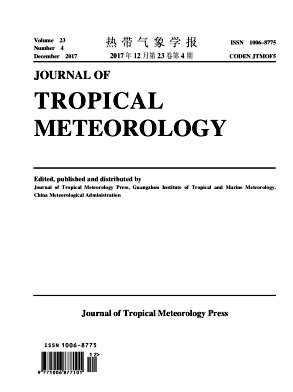PLANETARY BOUNDARY LAYER HEIGHT MEASURED BY A WIND PROFILER BASED ON THE WAVELET TRANSFORM
doi: 10.16555/j.1006-8775.2017.04.005
- Rev Recd Date: 2017-10-25
Abstract: Planetary boundary layer height (PBLH) is an important input parameter for any boundary layer study or model, either climate or atmospheric. The variation of the PBLH is also of great significance to the physical processes of numerical prediction, diagnosis of weather forecasting and monitoring urban pollutants. However, effective ways to monitor the PBLH continuously are lack. Wind profilers are commonly used in monitoring PBLH continuously because of its high temporal and spatial resolution, coupled with capability of continuous detection. In this paper, the covariance wavelet transform (CWT) is used to analyze the range-corrected signal-to-noise ratio (SNR) of the wind profiler to determine the PBLH, which is then compared with the results measured by the gradient method and the radiosonde. The conclusions are as follows: (1) The scaling parameter a and translation parameter b of the wavelet are critical in determination of the PBLH by applying the CWT as different values may get completely different results, which requires to select appropriate values in the calculation carefully. (2) Quality control is crucial in determining the PBLH because good quality control can help remove mutation points, which makes the determined PBLH more consistent with the actual situation. (3) In clear-air, the gradient method is not applicable if the boundary layer turbulence is inhomogeneous and the impact of noise is large for that it is easy to be impacted by the mutation of SNR caused by the atmosphere turbulence instability and other factors, which will cause large errors, while the CWT method as an improvement of the gradient method can determine the PBLH quite well. (4) Through quality control, the PBLHs determined by the CWT are consistent with those of radiosonde, and the correlation coefficient between them is 0.87.
| Citation: | AI Wei-hua, GE Shu-rui, WEI Hao, et al. PLANETARY BOUNDARY LAYER HEIGHT MEASURED BY A WIND PROFILER BASED ON THE WAVELET TRANSFORM [J]. Journal of Tropical Meteorology, 2017, 23(4): 396-407, https://doi.org/10.16555/j.1006-8775.2017.04.005 |

















 粤公网安备 4401069904700002号
粤公网安备 4401069904700002号
 DownLoad:
DownLoad: